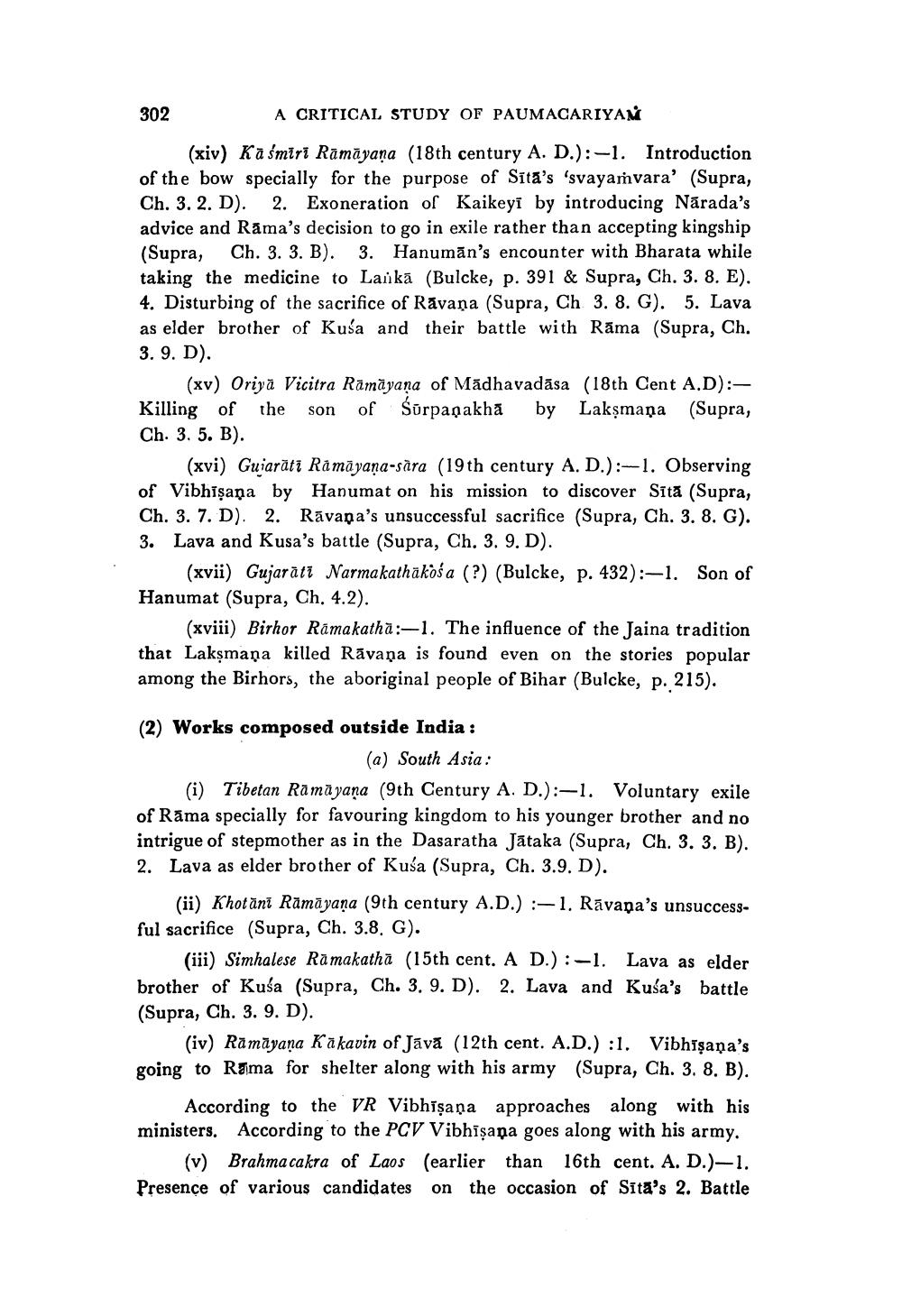________________
302
A CRITICAL STUDY OF PAUMACARIYAM
(xiv) Kā śmiri Rāmāyana (18th century A. D.):-1. Introduction of the bow specially for the purpose of Sīta's 'svayamvara' (Supra, Ch. 3. 2. D). 2. Exoneration of Kaikeyi by introducing Nárada's advice and Rāma's decision to go in exile rather than accepting kingship (Supra, Ch. 3. 3. B). 3. Hanumān's encounter with Bharata while taking the medicine to Laikā (Bulcke, p. 391 & Supra, Ch. 3. 8. E). 4. Disturbing of the sacrifice of Rāvaņa (Supra, Ch 3. 8. G). 5. Lava as elder brother of Kusa and their battle with Rāma (Supra, Ch. 3. 9. D).
(xv) Oriyā Vicitra Rāmāyana of Madhavadāsa (18th Cent A.D):Killing of the son of Surpanakha by Lakşmaņa (Supra, Ch. 3. 5. B).
(xvi) Guiarāti Rāmāyana-sara (19th century A. D.):-1. Observing of Vibhīşaņa by Hanumat on his mission to discover Sīta (Supra, Ch. 3. 7. D). 2. Rāvana's unsuccessful sacrifice (Supra, Ch. 3. 8. G). 3. Lava and Kusa's battle (Supra, Ch. 3. 9. D).
(xvii) Gujarati Narmakathākośa (?) (Bulcke, p. 432):-1. Son of Hanumat (Supra, Ch. 4.2).
(xviii) Birhor Rāmakathā:-1. The influence of the Jaina tradition that Lakşmana killed Rāvana is found even on the stories popular among the Birhors, the aboriginal people of Bihar (Bulcke, p. 215).
(2) Works composed outside India :
(a) South Asia: (i) Tibetan Rāmāyana (9th Century A. D.):-1. Voluntary exile of Rama specially for favouring kingdom to his younger brother and no intrigue of stepmother as in the Dasaratha Jātaka (Supra, Ch. 3. 3. B). 2. Lava as elder brother of Kuša (Supra, Ch. 3.9. D).
(ii) Khotāni Rāmāyaṇa (9th century A.D.) :- 1. Rāvana's unsuccessful sacrifice (Supra, Ch. 3.8. G).
(iii) Simhalese Rāmakatha (15th cent. A D.):-1. Lava as elder brother of Kuša (Supra, Ch. 3. 9. D). 2. Lava and Kuśa's battle (Supra, Ch. 3. 9. D).
(iv) Rāmāyaṇa Kakavin of Jāvā (12th cent. A.D.) :1. Vibhīşana's going to Rama for shelter along with his army (Supra, Ch. 3. 8. B).
According to the VR Vibhīşaņa approaches along with his ministers. According to the PCV Vibhișapa goes along with his army.
(v) Brahma cakra of Laos (earlier than 16th cent. A. D.)-1. Presence of various candidates on the occasion of Sīta's 2. Battle




